|
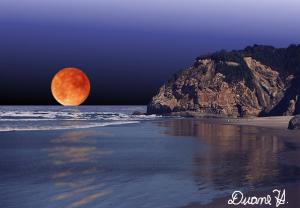 July 14, 2000 -- The
longest-lasting lunar eclipse in 140 years takes place this Sunday morning
when the Moon plunges into the deepest part of Earth's shadow for nearly
two hours. Judging from the appearance of the Moon during the last
lunar eclipse in January 2000, astronomers expect the Moon to turn a
striking reddish-orange color. The best sites for viewing this event will
be in Hawaii, the Pacific Ocean (including Oceania) and the Far East.
Early risers near the Pacific coast of the US will also be able to catch a
glimpse of the amber-shaded Moon as it sets over the southwestern horizon,
but the eclipse doesn't begin until well after moonset for most North
Americans. [eclipse
visibility charts and tables] July 14, 2000 -- The
longest-lasting lunar eclipse in 140 years takes place this Sunday morning
when the Moon plunges into the deepest part of Earth's shadow for nearly
two hours. Judging from the appearance of the Moon during the last
lunar eclipse in January 2000, astronomers expect the Moon to turn a
striking reddish-orange color. The best sites for viewing this event will
be in Hawaii, the Pacific Ocean (including Oceania) and the Far East.
Early risers near the Pacific coast of the US will also be able to catch a
glimpse of the amber-shaded Moon as it sets over the southwestern horizon,
but the eclipse doesn't begin until well after moonset for most North
Americans. [eclipse
visibility charts and tables]
Above: Artist Duane Hilton's rendition of an
eclipsed Moon sinking below the horizon of a distant Pacific
isle.
"This eclipse is especially long because the Moon passes right through
the middle of the darkest part of Earth's shadow. In places like
Australia, where the entire eclipse can be seen, totality will last for
108 minutes," says George Lebo, an astronomer at the NASA Marshall Space
Flight Center.
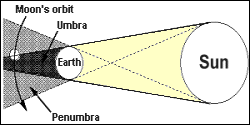 Unlike total solar eclipses, which persist
for a few minutes at most and can be seen only along a very narrow track
measuring a few kilometers across, lunar eclipses are slow and they are
visible over much of our planet when they happen. Unlike total solar eclipses, which persist
for a few minutes at most and can be seen only along a very narrow track
measuring a few kilometers across, lunar eclipses are slow and they are
visible over much of our planet when they happen.
A lunar eclipse takes place when the full Moon passes through our
planet's shadow. The Earth's shadow has a conical shape with two parts.
The umbra (on the inside) is very dark while the penumbra
(on the outside) is very weak. Lunar eclipses are considered total when
the Moon passes completely into the umbral shadow.
"You might think
that the Moon would be completely dark at totality, but it's not,"
continued Lebo. "Our planet's atmosphere refracts sunlight into the umbral
shadow, so even at maximum eclipse the Moon is weakly
illuminated."
The exact appearance of the eclipsed Moon depends on
how much dust and clouds are present in Earth's atmosphere. Total eclipses
tend to be very dark after major volcanic eruptions since these events
dump large amounts of volcanic ash into Earth's atmosphere. During the
total lunar eclipse of December 1992, dust from the eruption of Mount
Pinatubo in the Philippines rendered the Moon nearly invisible. Since no
major volcanic eruptions have taken place recently, the Moon will probably
take on a bright coppery color during the long total phase.
CONTINUES AFTER SIDEBAR
|
Lunar
Eclipses on the Moon
Future lunar colonists will undoubtedly
mark their calendars with dates when the Moon is expected to glide
through Earth's shadow. Earthlings would consider those events to be
lunar eclipses, but from the point of view of a Moon-dweller they
will be solar eclipses instead. A colonist standing on the Moon
inside Earth's penumbral shadow would see the disk of the Sun
partially covered by our planet. From a viewing site inside the
umbral shadow, they would see a total eclipse of the Sun.
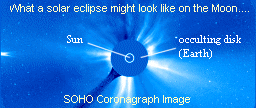 What would it look like? From a vantage point on the Moon,
the Earth appears to be 1.8 degrees wide while the Sun subtends an
angle of 0.5 degrees. A total solar eclipse would therefore look
much like images from the Solar and Heliospheric
Observatory's C3
coronagraph, which uses a 1.85 degree occulting disk to reveal
the Sun's faint outer corona. What would it look like? From a vantage point on the Moon,
the Earth appears to be 1.8 degrees wide while the Sun subtends an
angle of 0.5 degrees. A total solar eclipse would therefore look
much like images from the Solar and Heliospheric
Observatory's C3
coronagraph, which uses a 1.85 degree occulting disk to reveal
the Sun's faint outer corona.
Solar eclipses on Earth are notable
because the Moon and the Sun appear to be almost exactly the same
size (0.5 degrees wide). This leads to phenomena like Baily's Beads
and the Diamond Ring effect that would not be seen by eclipse
watchers on the Moon. However, any total solar eclipse would be
widely visible on the Moon. On Earth they are restricted to small
parts of our planet's
surface. |
To see this weekend's eclipse from the US west coast, go outside at
3:30 to 4:00 a.m. on Sunday morning and look southwest. The Moon enters
the Earth's outer (penumbral) shadow at 3:47 a.m. PDT. By 5 o'clock in the
morning the dark umbral shadow will begin to take a distinctive bite out
of the bright lunar disk. At that time, the setting Moon will be at an
altitude of just 10 degrees, so a clear view of the western horizon is
essential.
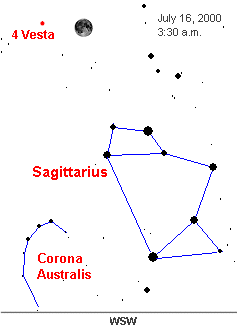 Left: During this weekend's
eclipse the full Moon will be approximately 20 degrees from the star clouds of
the Galactic Center in Sagittarius and just two Moon widths from the
5.4th magnitude asteroid Vesta. The asteroid and summer Milky Way may be
visible during totality. This star chart shows the appearance of the
southwestern sky at 3:30 a.m. Sunday morning, July 16, from San Francisco,
CA. Left: During this weekend's
eclipse the full Moon will be approximately 20 degrees from the star clouds of
the Galactic Center in Sagittarius and just two Moon widths from the
5.4th magnitude asteroid Vesta. The asteroid and summer Milky Way may be
visible during totality. This star chart shows the appearance of the
southwestern sky at 3:30 a.m. Sunday morning, July 16, from San Francisco,
CA.
Skywatchers in places like Hawaii and Australia where
the entire total phase of the eclipse can be seen are in for a
double-extra treat if they watch the event from a dark sky site. First,
the totally eclipsed Moon will lie approximately twenty degrees east of
the Sagittarius
star clouds. During partial phases of the eclipse these clouds will be
invisible, but during totality the beautiful summer Milky Way should be
easy to see. Also, the asteroid 4
Vesta will appear approximately one degree from the full Moon.
Coincidentally, Vesta is making a rare appearance as a naked-eye object on
July 16th as it nears solar opposition. (An
ephemeris of Vesta is available from the Harvard Center for
Astrophysics.) Sharp-eyed observers in dark rural areas may be able to
spot the minor planet during the total phase of the eclipse.
To
learn more about the geographic visibility of the eclipse and when to
look, please consult the charts and tables below. The table is based on a
similar one prepared by Sky
& Telescope magazine. The diagrams are from Fred Espenak's
comprehensive Eclipse
Home Page at the NASA/Goddard Space Flight Center.
Total Lunar Eclipse of July 16, 2000
| Event |
PDT |
Alaska |
Hawaii |
New
Zealand |
East
Australia |
| Moon enters
penumbra |
3:47 a.m. |
2:47 a.m. |
12:47 a.m. |
10:47 p.m. |
8:47 p.m. |
| First shading
visible |
4:25 a.m. |
3:25 a.m. |
1:25 a.m. |
11:25 p.m. |
9:25 p.m. |
| Partial eclipse
begins |
4:57 a.m. |
3:57 a.m. |
1:57 a.m. |
11:57 p.m. |
9:57 p.m. |
| Total eclipse
begins |
-- |
5:02 a.m. |
3:02 a.m. |
1:02 a.m.* |
11:02 p.m. |
| Mideclipse |
-- |
-- |
3:56 a.m. |
1:56 a.m.* |
11:56 p.m. |
| Total eclipse
ends |
-- |
-- |
4:49 a.m. |
2:49 a.m.* |
12:49 a.m.* |
| Partial eclipse
ends |
-- |
-- |
-- |
3:54 a.m.* |
1:54 a.m.* |
| Last shading
visible |
-- |
-- |
-- |
4:30 a.m.* |
2:30 a.m.* |
| Moon leaves
penumbra |
-- |
-- |
-- |
5:04 a.m.* |
3:04 a.m.* |
| Notes: This table is based on a similar one published by Sky &
Telescope magazine. All times in the table are local times on July
16 except for times marked by an asterisk, which refer to July 17,
2000. |
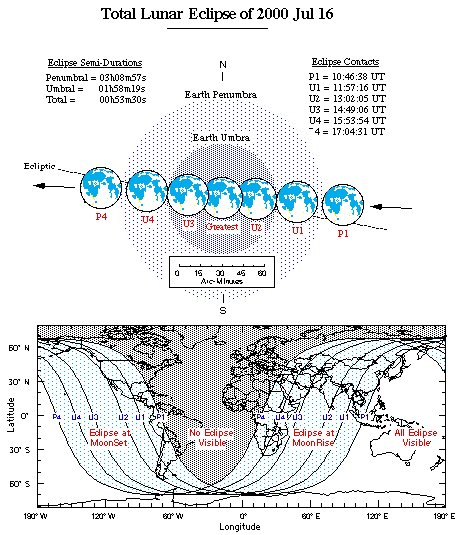 |



 Unlike total solar eclipses, which persist
for a few minutes at most and can be seen only along a very narrow track
measuring a few kilometers across, lunar eclipses are slow and they are
visible over much of our planet when they happen.
Unlike total solar eclipses, which persist
for a few minutes at most and can be seen only along a very narrow track
measuring a few kilometers across, lunar eclipses are slow and they are
visible over much of our planet when they happen.

 Left: During this weekend's
eclipse the full Moon will be approximately 20 degrees from
Left: During this weekend's
eclipse the full Moon will be approximately 20 degrees from  Headlines
Headlines